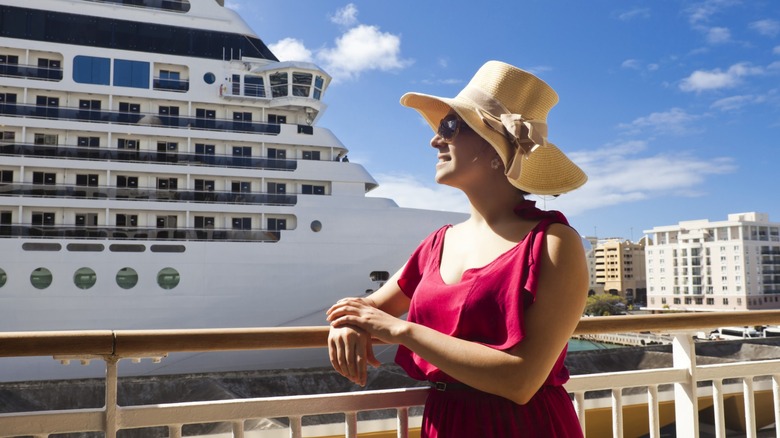If you’re a person who experiences seasickness when you’re on the water, a vacation cruise can seem like anything but fun. Nobody wants to be holed up with a trash can while their travel buddies are chilling around the lido deck or throwing back tropical drinks. Even if you’ve got a train case full of seasickness medications for your cruise, it can come with some fairly unpleasant side effects — like completely knocking you out or causing significant eye dilation that can interfere with your ability to focus. But the good news is that plenty of folks manage to negotiate their queasiness and actually enjoy themselves enough to take advantage of everything a cruise has to offer. That’s because travel veterans understand that managing seasickness doesn’t involve a panacea — sometimes it comes down to throwing everything but the kitchen sink at it.
Because everyone is different, we’ve combed through everything from Reddit recommendations to evidence-based research to find plenty of solid suggestions for banishing this all-too-common travel woe. When in doubt, try a little bit of everything and see what works best for you. Next time you’re traveling on the water, don’t forget to try out these unconventional hacks for staving off seasickness.
Change your surroundings
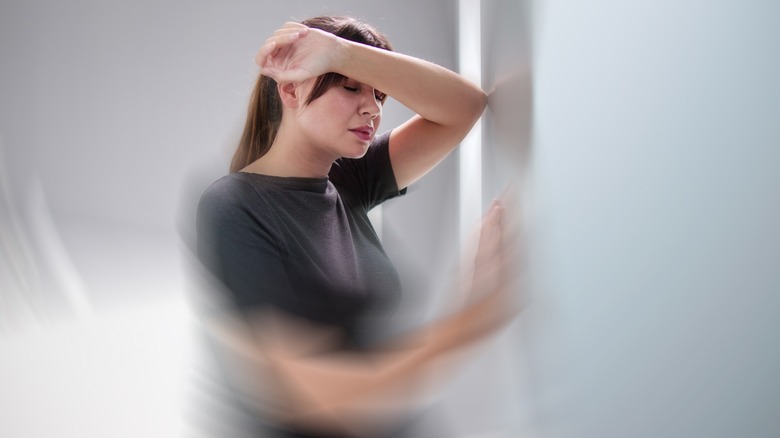
When you’re feeling queasy, holing up in your stateroom can seem like the best of all bad choices. And it can be a real drag to spend your seafaring vacation looking at four walls. While it may feel counterintuitive, forcing yourself to get up and stretch your legs above deck in the fresh air can actually help calm your seasickness.
It’s a suggestion that comes up again and again on Reddit, particularly on forums with folks who have extensive experience on the ocean. One Redditor recommends, “Stay above deck, get some water, and stay moving and you’ll feel much better much sooner.” Echoing the sentiment, another user advised, “You need to get above decks and lock eyes on land.”
That’s because getting out of cramped quarters and above deck exposes you to fresh air, which both research and doctors’ anecdotal experience demonstrate can help with symptoms of seasickness. According to a study by Temperature, motion sickness has been shown to directly impact the body’s thermoregulation, causing the body temperature to drop. Perhaps somewhat paradoxically, this causes the ill person to become flushed or even hot as their body attempts to regulate their temperature. Fresh air can help to reset the system while you gradually become physiologically accustomed to the new status quo.
Be conscious of your triggers
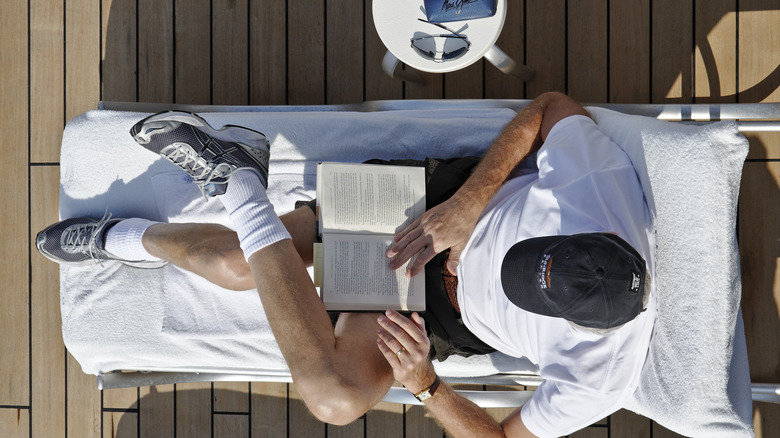
Like all forms of motion sickness, seasickness isn’t a one-size-fits-all ailment. Individuals suffering from seasickness can even have their own unique triggers — the key is in trying to understand what yours are so you can avoid them. Every time you experience an uptick in motion sickness, try working through some of the things that might have caused it so you can potentially mitigate future problems.
Just as looking out a side car window can trigger motion sickness, it’s possible that looking at certain things could make your seasickness worse. Fatty and greasy foods are also thought by many experienced sailors to be a contributing factor for some folks. If this is the case for you, it’s probably best to skip the cruise ship buffet altogether in favor of lighter fare. Others will swear that drinking caffeine can intensify a person’s motion sickness, so switching to half-caf for your morning latte while on vacation might be worthwhile. And if you’re the kind of person who experiences motion sickness when you try to read in a car, you might be better off switching to audiobooks for your vacation. Crowds, dehydration, exposure to secondhand smoke — whatever your triggers, the key to reducing their effect on your vestibular system begins with identifying them so you know what to avoid.
Maintain healthy habits
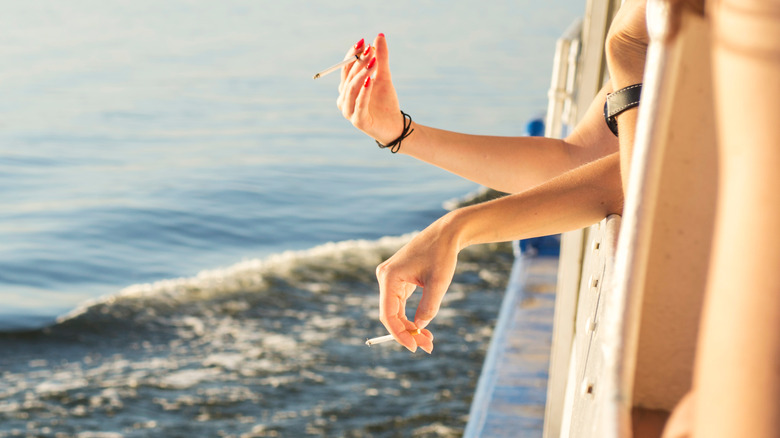
Andrii Spy_k/Shutterstock
While it’s always a good idea to keep up with healthy lifestyle habits, taking good care of your body can affect the way you handle motion sickness. And there’s a ton of data to support this. For starters, make sure to get plenty of sleep while you’re on your cruise. A 2016 study in Autonomic Neuroscience concluded that sleep deprivation could reduce individuals’ ability to adapt to motion sickness while having an additive effect in terms of motion sickness severity. In other words, getting enough sleep can help you to bounce back faster.
If you’re a smoker and you know you suffer from seasickness, this could be the excuse you need to cut back before your trip since smoking has also been found to affect motion sickness. In a 2010 Autonomic Neuroscience study, researchers found that short-term smoking cessation helped to reduce motion sickness symptoms. This is backed up by the CDC recommendation that “Quitting (even short-term) reduces susceptibility to motion sickness.” And not to be a buzzkill, but slowing down on the booze can also help to reduce motion sickness — which kind of makes sense since drinking enough can literally give you the spins. This is because alcohol does a number on your vestibular system — the mechanism in your inner ear that helps you maintain your balance and interpret motion and your body in space.
Take some ginger or mint

g images.com/Shutterstock
Ask just about anyone who has experienced pregnancy-related nausea, and they’ll likely tell you that ginger can be a godsend for managing pretty intense queasiness. According to Johns Hopkins Medicine, that’s because ginger contains gingerol, a type of compound with so many naturally occurring health benefits that it’s not hard to see why some folks swear it’s nature’s miracle cure. Experts say ginger helps to stave off nausea by encouraging gastrointestinal motility — in other words, it gets your intestines moving things along a bit more efficiently. It can also help to cut down on gas and bloating you might experience when you start to feel a little better and decide to hit the buffet. And that’s to say nothing of gingerol’s antioxidant properties or association with anti-inflammatory and pain-relieving effects. Whether you’re already a bona fide ginger lover or can’t stand the flavor, there are plenty of ways to take it, from ginger teas and candies to easy-to-swallow ginger capsules.
If ginger doesn’t work for you, try adding some peppermint to your diet, which also may help to ease motion sickness. As an added bonus, studies have found that chewing gum can have a mitigating effect on visual-related motion sickness. If staring at waves is causing you grief, picking up a pack of peppermint gum might be just what the doctor ordered.
Give your eyes a break

Igortsarev/Getty Images
Even on vacation, most folks are glued to their phones these days — it’s just a fact of life in the modern age. But if you’re prone to seasickness, think of it as the universe giving you a sign that it’s time to take a technology break. Just like reading a book can have a multiplying effect on motion sickness, so can looking at your phone.
Although researchers are only just beginning to understand the issue, prolonged screen usage is becoming increasingly associated with a condition called cybersickness. According to Iowa State University, “Cybersickness refers to a cluster of symptoms that occur in the absence of physical motion, similar to motion sickness. These symptoms fall into three categories: nausea, oculomotor issues and general disorientation.” And it doesn’t take a neuroscientist to understand how this could play out for someone already suffering from seasickness.
Even if you’re not looking at a book or phone, experts say focusing your eyes on a single point along the horizon can help your brain process the motion of the ocean. And there are plenty of folks who swear by this. As one Reddit user put it on the excellent Explain Like I’m Five subreddit, “It gives your mind a frame of reference to determine exactly what is level. When you know what ‘level’ is, your brain can deal with the motions reported by your inner ear.” And when you’re truly desperate, it’s never a bad idea to take a midday nap.
Listen to music
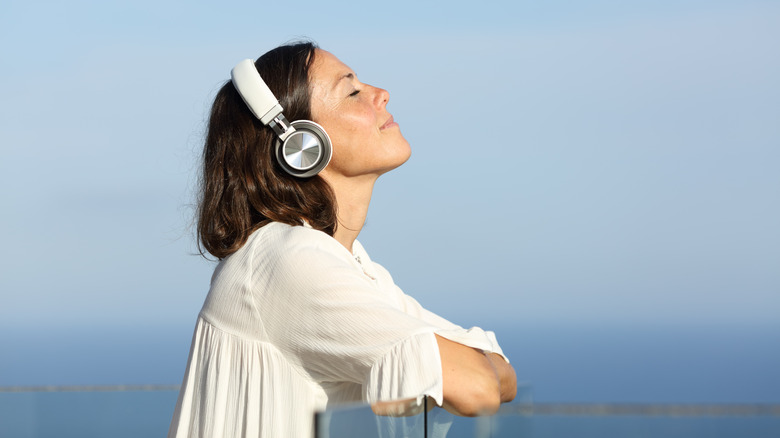
Pheelings media/Shutterstock
Music can be soothing under the worst of circumstances, so it makes sense that breaking out the headphones might help you calm an unwieldy vestibular system. That music can reduce motion sickness has been well-proven, with many studies supporting the relationship, according to Drugs in Context’s research overview. According to the authors, one study “found that the mean motion exposure time in minutes tolerated before the onset of nausea was significantly longer for music.” And it’s not just any old music.
Researchers publishing in Applied Ergonomics looking at visually induced motion sickness (VIMS) found that pleasant or relaxing music has a reducing effect on the condition. The study assigned listeners to groups that listened to either no music, stressful music, neutral music, or relaxing music before immersing them in a 14-minute bike ride video and following it up with a motion sickness study. The researchers concluded that among the four groups, only relaxing music had a reducing effect on the participants with one caveat — that the music had to be perceived as pleasant by the listener. To try this out for yourself, download a relaxing playlist ahead of your trip and bring some good noise-canceling headphones along for the ride.
Try some lavender or aromatherapy
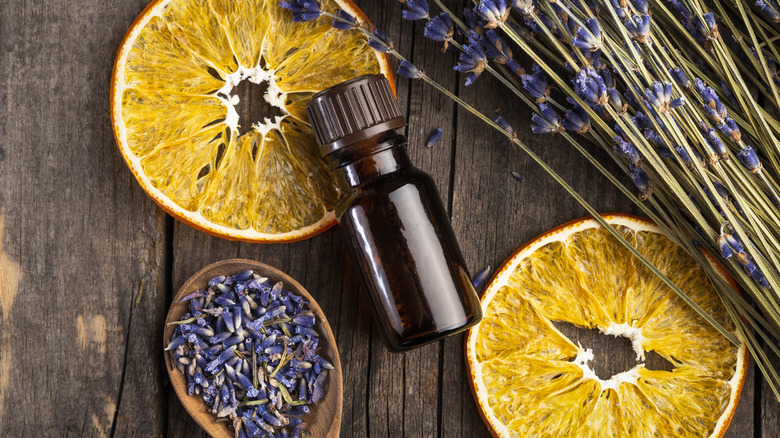
5./15 West/Getty Images
Lavender and other aromatherapies have been extensively studied for their effects on various types of nausea. In particular, lavender reduces nausea in individuals with several conditions, including pregnancy and postoperative nausea. Like their edible formats, peppermint and ginger fragrances seem to have medicinal properties when used as aromatherapy. Since using these complementary therapies tends to be generally relaxing, you can’t lose by trying them unless you happen to be allergic or sensitive to the smell.
If this is your first time using aromatherapy, Healthline advises using caution and discontinuing if you experience an adverse reaction. Better yet, it’s probably a good idea to try out new aromatherapy before you find yourself stranded in the middle of the ocean with hives on top of motion sickness since cruise ships don’t always have complete medical facilities.
To use aromatherapy, you can either inhale essential oils directly or bring along a travel diffuser. Alternatively, add a few drops to your toiletries or try mixing them with carrier oil so you can dab them in hot spots like behind your ears or the back of your neck.
Try deep breathing
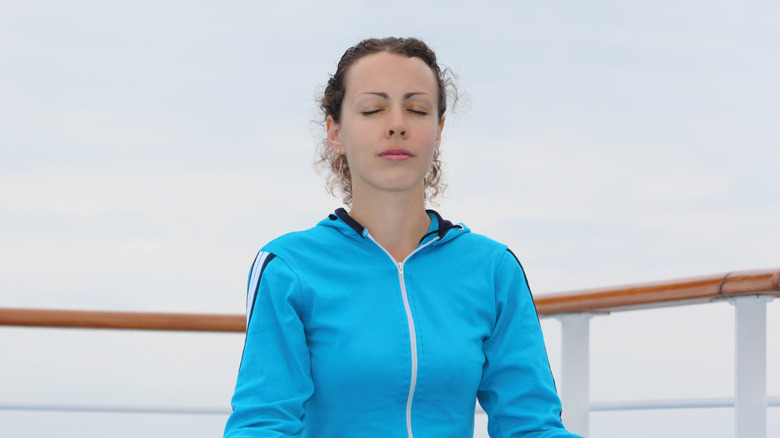
Pavel L Photo and Video/Shutterstock
For most folks, it only takes one bad hangover or bout of norovirus to learn that deep breathing is one of the best ways to slow down the nausea train. Researchers say there’s even a best practice for deploying this tried-and-true method for calming the uneasy gut. A 2015 study in Aerospace Medicine and Human Performance found that controlled, diaphragmatic breathing was associated with reports of reduced motion sickness after viewing footage of a boat on rough seas through VR.
Researchers associated with the study believe this type of breathing maximizes an individual’s parasympathetic nervous system tone. Put another way, it helps to relax all those fight-or-flight systems that make nausea and motion sickness even worse. It can even help to induce sleep when it’s time to crash for the night or help reduce your perception of pain — both things that may become an issue if your motion sickness gets gnarly enough. The good news is that it’s a technique even preschoolers are capable of learning, so just about anyone can master it.
To try it out, start by breathing at your usual rate. Be sure to inhale through your nose while breathing out through pursed lips. Count each breath in your mind, beginning with “in, two, three” on the inhale and “out, two, three” on the exhale. This will help you to regulate your breaths, increasing your oxygen while lowering your blood pressure and causing overall relaxation.
Take an antihistamine

EHStockphoto/Shutterstock
Even if you don’t suffer from allergies, an antihistamine could turn out to be a real game changer on your cruise vacation. Promethazine, also called Phenergan, is a relatively strong prescription antihistamine that has long been used to combat nausea in hospital and healthcare settings, but it turns out that you can get many of the same benefits in an over-the-counter antihistamine like Benadryl. While some travelers advise that Benadryl is shorter-acting than a motion sickness med like Dramamine, they see this as a feature and not a bug since this means it will take effect pretty quickly.
Even so, it’s probably best to consider this a last resort. Like many other seasickness medications, an antihistamine like Benadryl will likely make you sleepy or, in some severe cases, even knock you out. But as one wisecracking Reddit commenter put it, “Can’t get sick if you’re asleep.” Wise words.
Use visuospatial training exercises
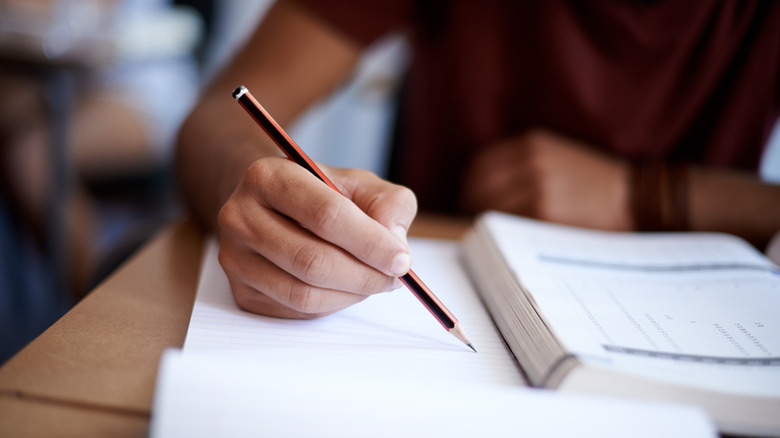
Peopleimages/Getty Images
File this one under “extra homework.” For folks who are seriously invested in conquering their motion sickness, some experts say visuospatial training exercises could be the key. In 2021, a group of researchers published their work in Applied Ergonomics on what they called a “novel visuospatial training tool,” and the results look promising. The authors conducted a study that looked at motion sickness in both on-road and driving simulator trials. Participants took part in 15 minutes of pen-and-paper tasks each day for 14 days aimed at improving their visuospatial skills.
According to the study authors, participants’ visuospatial skills had improved by 40% by the end of the training period, which they concluded was “directly responsible for a reduction in motion sickness.” Although the study’s authors did not share their specific recipe for visuospatial magic, examples of similar exercises are fairly easy to find with a simple Google search.
Take a CBD supplement

Aiman Dairabaeva/Shutterstock
The anti-nausea benefits of cannabis are widely known, but not everyone realizes they don’t have to catch a buzz or use any substances that could cause trouble in their workplace to take advantage of these benefits. Cannabidiol (CBD) is an incredibly beneficial chemical found in the cannabis plant, and it can be purchased just about anywhere these days. That’s because it doesn’t contain tetrahydrocannabinol (THC), the psychoactive chemical that an overly enthusiastic DARE officer warned your class about back in the day.
According to the British Journal of Pharmacology, “The anti-emetic effect of cannabinoids has been shown across a wide variety of animals that are capable of vomiting in response to a toxic challenge.” Since CBD has also been found to decrease anxiety at just about any dose, this knocks out two of the most aggravating aspects of seasickness in one punch.
CBD can be taken in several ways, including as a tincture, capsule, lozenge, gummy, or spray — just to name a few. If you’re choosing to make your purchase online, be sure you’re purchasing from a reputable retailer.
Try using acupressure
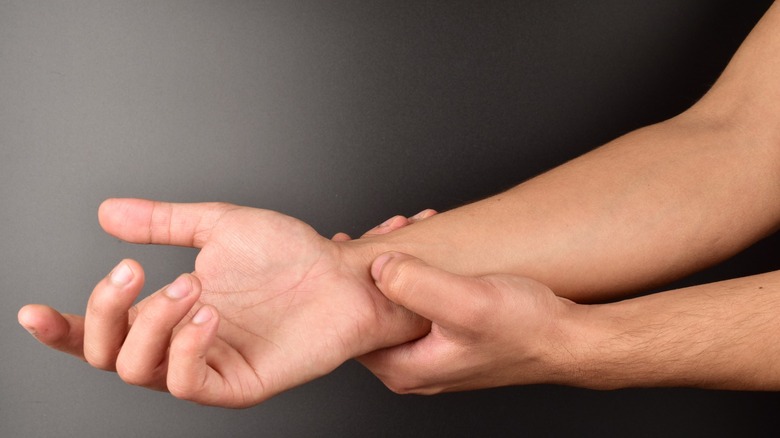
Funstock/Shutterstock
If you’ve never had a reason to try acupressure, consider checking out acupressure solutions before you set sail since they can offer real relief for some folks. And it’s not just anecdotal — acupressure is an alternative medicine solution that has been proven to help with seasickness. Researchers in a 2001 study in Alternative Therapies in Health and Medicine found that the pressure on the P6 point (also called the Neiguan point) was linked to “significantly fewer symptoms of motion sickness” and “less abnormal gastric activity” than subjects experienced on control days. This is backed up by a 2017 Journal of PeriAnesthesia Nursing study that found P6 acupressure had a mitigating effect on nausea intensity while aiding patient comfort. That’s probably why it’s been practiced in China for thousands of years.
If you’re planning to try it out yourself, there are a few things to consider before getting started. You should only perform acupressure on healthy, unbroken skin — avoid using it on skin with a rash, open wound, blistering, peeling, warmth, swelling, redness, or another form of damage. Many medical institutions and hospitals offer online video guides to reducing nausea through acupressure. After you’ve found one you like, be sure to download it to your phone so you’ve got it handy when you need it on your trip. And don’t forget to practice ahead of time since having that muscle memory could mean all the difference when the ocean starts to do its thing.
Roll yourself into a burrito
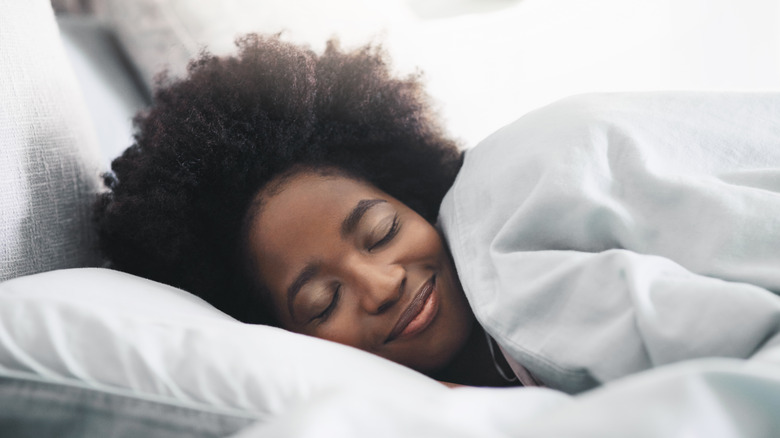
Adene Sanchez/Getty Images
If all else fails, you can always embrace the “burrito” hack for reducing your sense of motion in space, a tip that’s nothing short of brilliant. The idea is to create a sort of DIY cocoon that shuts you off from the sensory overload you’ve been putting your body through long enough to reset your vestibular system.
To make it happen, you’ll need to grab your cabin’s lifejackets, shoving them underneath your mattress to lift one side of your bed, forming an angle against the wall. This gives you your very own little burrito-like hideout to escape from the constant back-and-forth of the ship’s horizontal motion. Nestled cozily between the mattress and wall, you don’t have to worry about getting rolled around, leaving you free to chillax and work on hard-restarting your wave-weary vestibular system. Now all you need is to slap on some lavender aromatherapy, pop a CBD gummy, and break out the Chopin playlist — a few hours of sleep in your cabin burrito, and you’ll be right as rain.

